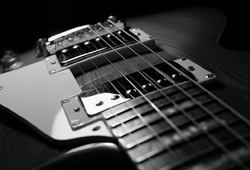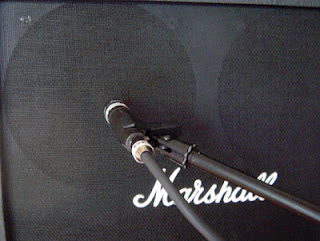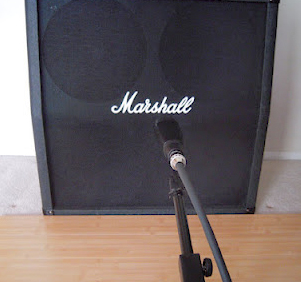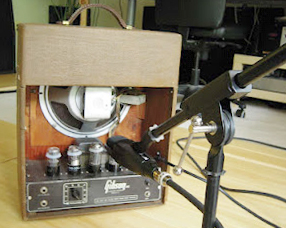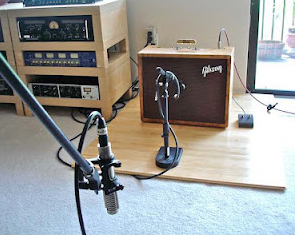Every guitar player, engineer and producer wants to record the ultimate guitar sound, but it’s not always easy to capture the great sound that you hear in the room.
In this excerpt from The Ultimate Guitar Tone Handbook (written with my good friend, television composer and great guitarist Rich Tozzoli), we’ll look different electric guitar mic’ing techniques.
While many believe there’s only one accepted way to mic an amplifier, you’ll be surprised to learn that there are as many ways as there are guitar and amp sounds.
Let’s look at some.
Using A Single Mic
It’s amazing what you can do with a single mic if you experiment a bit. Here are a number of techniques that have been used on popular recordings since the 50s.
They all work, but remember that what works for one recording may not work for another.
That’s why it’s good to always have an alternative in your pocket when you need one.
The Classic Setup
Place a Shure SM57 about one inch away from the best sounding speaker in the cabinet. Place the mic about three quarters of the way between the edge of the speaker and the voice coil (away from the voice coil).
If you need more high end, move the mic towards the voice coil (the center of the speaker). If the sound needs more body, move it towards the outside edge of the speaker. Make sure that the mic does not touch the speaker cone when the loudest passages are played.
The Old School Setup
The way amplifier mic’ing was consistently done in the 60s and 70s was to place the mic from one to two feet away from the center of the speaker or speakers. This allows the sound from the speakers and the cabinet to develop, but also captures some of the room, which can be a nice bonus.
The ideal distance on a cabinet with two speakers is where the output of both speakers combine. Move the mic to the side to capture more of the sound of one of the speakers voice coils if more high end is required.
Mic’ing A Marshall 4×12
If you’re using a Marshall 4×12 cabinet, position a single mic 12 to 24 inches from the cabinet, dead center to all 4 speakers aiming for the logo plate. You can use this for other closed back cabinets as well, except their logo’s might not be in the same position.
On the typical 4×12 speaker cabinet (like the standard Marshall 1960 model), the four speakers usually become additive at a distance of 15 to 24 inches from the cabinet center (depending upon the speakers).
Using Two Mics
As much of a variety as you can get with one mic, you’ll get a lot more with two.
Over the years, many engineers discovered that they could more closely capture the sound that they were hearing in the room by adding a second microphone.
Here are some examples.
The Classic Two Mic Setup
Place the SM57 near or against the grill cloth as in the classic method #1 above. Now add a Sennheiser MD 421 at the same position to the right of the 57, but aimed at a 45 degree angle pointing towards the voice coil.
Many sounds can be achieved from this setup by summing the mics at different levels and by flipping the phase on one.
Of course, you can use any mics you choose, but the classic setup uses the 57 and 421.
Two Mic Variation #1
With an open-back amplifier (like a typical Fender), place a mic about a foot away from the rear of the amp, off center from one of the speakers, while using any of the single mic setups for the front of the cabinet.
Usually you’ll have to flip the phase on the rear mic, but try both positions and use the one that has the most low-end.
Two Mic Variation #2
While using the mic setting from the single mic Classic #1 with the mic close to the grill of the cabinet, add an additional mic at the spot where the sound of the speakers converge 18 to 24 inches away.
This distance might be increased to as much as six feet depending upon the size and sound of the room, which will then increase the captured ambience.
Other guitar amp mic’ing setups can be far more sophisticated using a lot more mics, but one of these methods can get you where you need to go most of the time.
Don’t forget that everything starts with the player, instrument and amplifier first. If the sound is crappy at the amp, there’s nothing you can do to make it sound better via the mic’ing.
Get a great sound first, then pick your choice of mic’ing.
Bobby Owsinski is an author, producer, music industry veteran and technical consultant who has written numerous books covering all aspects of audio recording. For more information be sure to check out his website and blog.


